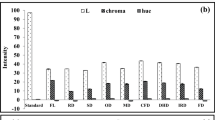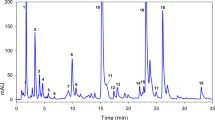Abstract
Dried green leafy vegetables constitute a major dietary source of provitamin A carotenoids for people living in semi-arid areas of Tanzania. In the present study, eight vegetable varieties commonly consumed in these areas were either traditionally sun-dried or solar-dried, and the amount of provitamin A carotenoids were determined by HPLC. In the fresh blanched leaves, the contents of β-carotene, α-carotene, 9-cis-β-carotene and 13-cis-β-carotene were in the range of 526–917, 12–39, 80–136 and 16–40 μg/g dry matter/basis; dmb, respectively. The average amounts of all-trans-β-carotene in the leaves after blanching, solar drying and open sun-drying were 662, 502 and 353 μg/g dmb, respectively, all significantly different from each other (p <0.001). The average amounts of all-trans-α-carotene were 21, 15 and 8 μg/g dmb (p <0.05) and of 9-cis-β-carotene 101, 82 and 63 μg/g dmb (p <0.05) in the blanched, solar-dried and open sun-dried samples, respectively. Estimation of the amount of retinol equivalents provided by the dried vegetables for preparation of an edible portion of 100 g relish showed that solar-dried vegetables contributed more (between 120–275%) than the recommended level of vitamin A, and on average 43% more retinol equivalents than relishes of open sun-dried vegetables.
Thus, it is concluded that the amount of provitamin A-carotenes in traditionally treated vegetables were highly reduced by open sun-drying while solar drying resulted in significantly more retention of the carotenes. All-trans-α-carotene and 9-cis-β-carotene were similarly affected as all-trans-β-carotene by the two drying methods. Consumption of a 100 g portion of solar-dried vegetable relish could provide the recommended daily intake of vitamin A.
Similar content being viewed by others
References
Kavishe FP, Mushi S (1993) Nutrition relevant actions for Tanzania UN ACC/SCN country case study for the XV congress of the International union of Nutritional Sciences, 26 September-1 October 1993, Adelaide, Australia.
Pepping F (1987) Xerophthalmia and post-measles eye lesions in children in Tanzania. PhD thesis, International Agricultural Centre, University of Wageningen, The Netherlands.
Pepping F, Vencken CMJ, West CE (1988) Retinol and carotene content of foods consumed in East Africa determined by high performance liquid chromatography. J Food Sci Agric 45: 359–71.
Maeda EE, Salunkhe DK (1981) Retention of ascorbic acid and total carotene in solar-dried vegetables. J Food Sci 46: 1288–90.
Mosha TC, Pace RD, Adeyeye S, Laswai HS, Mtebe K (1997) Effect of traditional processing practices on the content of total carotenoid, β-carotene, α-carotene and vitamin A activity of selected Tanzanian vegetables. Plant Foods Hum Nutr 50: 189–201.
Mulokozi G, Mselle L, Mgoba C, Mugyabuso JKL, Ndossi GD (2000) Improved solar drying of vitamin A rich foods by women groups in Singida District of Tanzania. ICRW/OMNI Research Report Series 5, International Centre for Research on Women, Washington DC.
Edwards CG, Lee CY (1986) Measurement of provitamin A carotenoids in fresh and canned carrots and green peas. J Food Sci 51: 534–35.
Negi PS, Roy SK (2000) Effect of blanching and drying methods on β-carotene, ascorbic acid and chlorophyll retention of leafy vegetables. Lebensm Wiss u-Technol 33: 295–298.
Thane C, Reddy S (1997) Processing of fruits and vegetables: effect on carotenoids. Nutr & Food Sci 2: 58–65.
Clydesdale FM, Ho CT, Lee CY, Mondy NI, Shewfelt RL (1991) The effects of postharvest treatment and chemical interactions on the bioavailability of ascorbic acid, thiamine, vitamin A carotenoids and minerals. CRC Crit Rev Food Sci Nutr 30: 599–638.
Simpson KL (1983) Relative value of carotenoids as precursors of vitamin A. Proc Nutr Soc 42: 7–11.
Kopas-Lane LM, Warthesen JJ (1995) Carotenoid photostability in rawspinach and carrots during cold storage. J Food Sci 60: 773–76.
Lessin WJ, Catigani Gl, Schwartz SJ (1997) Quantification of cis/trans isomers of provitamin A carotenoids in fresh and processed fruit and vegetables. J Agric Food Chem 45: 3728–32.
Gomez MI (1981) Carotene content of some green leafy vegetables of Kenya and effects of dehydration and storage on carotene retention. J Plant Foods 3: 231–44.
Park WY (1987) Effect of freezing, thawing, drying and cooking on carotene retention in carrots, broccoli and spinach. J Food Sci 52: 1022–25.
Speek AJ, Speek-Saichua S, Schreurs WHP (1988) Total carotenoid and ß-carotene contents of Thai vegetables and the effect of processing. Food Chem 27: 245–257.
Nyambaka H, Ryley J (1996) An isocratic reversed-phase HPLC separation of the stereoisomers of the provitamin A carotenoids (α and β-carotene) in dark green vegetables. Food Chem 55: 63–72.
Benhura MAN, Chitsiku IC (1997) The extractable β-carotene content of Guku (Bidens pilosa) leaves after cooking, drying and storage. Int J Food Sci Technol 32: 495–500.
Haralampu SE, Karel M (1983) Kinetic models for moisture dependence of ascorbic acid and ß-carotene degradation in dehydrated sweet potato. J Food Sci 48: 1872–3.
Ramakrishnan TV, Francis FJ (1979) Stability of carotenoids in model aqueous systems. J Food Quality 2: 177–89.
AOAC (1995) Official Methods of Analysis, Section 4.1.06, 16th ed. Arlington, VA: Association of Official Analytical Chemists.
Pettersson A, Jonsson L (1990) Separation of cis-trans isomers of alpha-and beta-carotene by adsorption HPLC and identification with diode array detection. J Micronutr Anal 8: 23–41.
Davis BH (1976) Carotenoids. In: TW Goodwin (ed), Chemistry and biochemistry of plant pigments, 2nd ed., vol 2. London: Academic Press, pp 38–165.
Ramos DMR, Rodriguez-Amaya DB (1987) Determination of the vitamin A value of common Brazilian leafy vegetables. J Micronutr Anal 3: 147–55.
Khachik F, Beecher GR, Whittaker NF (1986) Separation, identification and quantification of the major carotenoid and chlorophyll constituents in extracts of several green vegetables by liquid chromatography. J Agric Food Chem 34: 603–16.
Kimura M, Rodriguez-Amaya DB, Godoy HT (1990) Assesment of the saponification step in the quantitative determination of carotenoids and provitamins A. Food Chem 35, 187–195.
Craft NE, Granado-Lorencio F (1992) Effect of sample preparation on fat soluble vitamin and carotenoid concentrations. Paper presented at the </del>experimental Biology meeting, 25 March to 2 April 1992, New Orleans, USA.
Sweeney JP, Marsh AC (1971) Effect of processing on provitamin A in vegetables. J Am Diet Assoc 59: 238–43.
Chandler LA, Schwartz SJ (1988) Isomerization and losses of trans-â-carotene in sweet potatoes as affected by processing treatments. J Agric Food Chem 36: 129–133.
Rodriguez-Amaya DB, Tavares CA (1992) Importance of cis-isomer separation in determining provitamin A in Tomato and tomato products. Food Chem 45: 297–302.
Subadra S, Monica J, Dhabhai D (1997) Retention and storage stability of beta carotene in dehydrated drumstick leaves (Moringa oleifera). Int J Food Sci Nutr 48: 373–76.
FAO/WHO (1988): Requirements of vitamin A, iron, folate and vitamin B12 Report of a joint FAO/WHO expert consultation. FAO Food Nutr Ser no. 23. Rome.
WHO/UNICEF (1995): Global prevalence of vitamin A deficiency. WHO Micronutrient Deficiency In formation System (MDIS), Working paper no. 2, WHO/NUT/95.3. Geneva: World health Organization/United Nation's Children's Fund.
de Pee S, West CE, Muhilal Karyadi D, Hautvast JGAJ (1995) Lack of improvement in vitamin A status with increased consumption of dark-green leafy vegetables. Lancet 346: 75–81.
de Pee S, West CE, Permaesih D, Muhilal SM, Hautvast GAJ (1998) Orange fruit is more effective than are dark-green, leafy vegetables in increasing serum concentrations of retinol and β-carotene in school children in Indonesia. Am J Clin Nutr 68: 1058–67.
van het Hof KH, Gärtner C, West CE, Tijburg LBM (1998) Potential of vegetable processing to increase the delivery of carotenoids to man. In J Vitam Nutr Res 68: 366–70.
Institute of Medicine (2000) Dietary reference intakes for vitamin C, vitamin E, Selenium and carotenoids. Institute of Medicine, Washington DC, USA.
Author information
Authors and Affiliations
Rights and permissions
About this article
Cite this article
Mulokozi, G., Svanberg, U. Effect of traditional open sun-drying and solar cabinet drying on carotene content and vitamin A activity of green leafy vegetables. Plant Foods Hum Nutr 58, 1–15 (2003). https://doi.org/10.1023/B:QUAL.0000041153.28887.9c
Issue Date:
DOI: https://doi.org/10.1023/B:QUAL.0000041153.28887.9c




